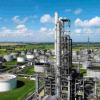|
|
Vertical Exchanger, 1/3 Pass Question.
#1

Posted 03 November 2008 - 06:39 AM
We have a vertical condenser with shell side single pass (process side) and tube side 3 pass (CW side) configuration. CW inlet is at the top and outlet is at the bottom. Process is countercurrent, that is inlet is at the bottom and outlet is at the top.
We have faced recurring problem of CW side solid deposition in 3rd and 2nd pass. 3rd pass is the most affected. CW outlet temperature is also very high as compared to design showing less CW flow requirement to control process side outlet temperature, which is done through a control valve at CW outlet.
We are evaluating various options of addressing the problem. There is one question:
Is it possible that since CW flow in the third pass is from top to bottom and there is no surity of complete wetting of the tubes and also since CW temperature in the third pass is the highest, the solid gets deposited more here due to high temperature evaporation. CW outlet max temperature reaches 88-89 degC.
Is there any resource to check the deposition rate at elevated temperatures in CW. Here CW is cooled using see water and runs in close loop.
Any body faced similar problem? Suggessions are welcome.
Thanks
#2

Posted 03 November 2008 - 07:26 AM
88-89C cooling water outlet temperature is tremendously high - it should never exceed 45-48C, otherwise heavy fouling occurs. Something is deeply wrong with the design and/or operation of your exchanger.
#3

Posted 03 November 2008 - 09:06 AM
Sahajmal Biswas
#4

Posted 03 November 2008 - 09:17 AM
Please stop making multiple postings of the same thread. Read the Forum Guidelines. I deleted your duplicate posting in the Professional Forum.
Zauberberg is completely correct. Something IS wrong with this design/application.
Please study my comments included in the attached workbook.
All engineers should employ clear, detailed and accurate drawings to illustrate their problems. It is so much simpler to explain things with a sketch.
 Vertical_Condenser_Configuration.zip 29.04KB
100 downloads
Vertical_Condenser_Configuration.zip 29.04KB
100 downloads
#5

Posted 03 November 2008 - 09:49 AM
I fully agree with previous comments regarding CWR temperature limitations. You should troubleshoot your installation to determine the reason for deviation from design. Also, the more common configuration would have CWS entering the bottom and CWR exiting from the top of the exchanger. This enhances natural convection and can sweep any released gases from the system. It is also closer to countercurrent, with cold CW in bottom and out top, and "hot" process vapors in top and cooler condensate out the bottom. Throttling the CW flowrate is generally not good. To minimize fouling, it is best to run the CW flow "full out" if at all possible. My final point is that your reported 3 tube pass exchanger would be extremely unusual and probably quite expensive to manufacture. I have never seen a 3 pass heat exchanger and can't really imagine the purpose for having one.
#6

Posted 03 November 2008 - 12:30 PM
Dear omnibus hello,
Please Check if this is end of loop from CW supply/return circiut viewpoint
Velocity on Cooling water side must be increased.
Review actual values against original design heat duties (both sides)
Even severe water hammer and damages may result if not addressed adequately at the earliest.
Regards
Qalander
#7

Posted 09 November 2008 - 04:30 AM
Yes, we are evaluating an existing condenser. Actually, it is an MP Condenser in Urea - snamprogetti design plant, and inlet/outlet both are mixed phase (liq/vapor).
I tried attaching a sketch of the layout (word file), but could not upload. I will go through the FAQ and find out and then upload asap. Actually, we are evaluating various options including Co-current (both process and CW inlet at the bottom) to keep the CW outlet temperature always at least below the process outlet temperarture. Also, we are evaluating single pass design to decrease delta T on CW side and therby make it possible to increase the CW flow required to control the process outlet temperature.
We are also evaluating the existing design for possiblity of using the same exchanger with CW side inlet /outlet reversed ( Nozzles are same size). We can do all the above once we are ready with our model in TASC, as there is also exothermic heat of reaction ( CO2+ ammonia <-> Amm Carbamate) to be accounted for. The PFDs have been no help in solving this problem as the reaction is not represented anywhere.
Hello Art,
Thanks a million for attaching the detailed comments. Actually, it is a partial condenser where CO2 gets absorbed and process inlet and outlet both are mixed phase (vapour+liquid). Only, in the outlet liquid phase is more than in inlet. You have depicted the position of the nozzles in the first figure of your attached diagram, but the process inlet contains both liquid and vapor as outlet does. Sorry could not attach a file showing the sktch.
Any comments are welcome.
#8

Posted 09 November 2008 - 04:43 AM
Dear Qlander,
Thanks for the suggession. Yes, velocity needs increasing but in the present scenario cooling water flow cannot be increased to maintain the process outlet temperature. So, we are evaluating alternative design.
Also we have checked the actual values (temperatures) against design values. CW outlet design temperature at design load is 65 degC. Actual temperature is 78-89 deg. Even when cooling water temperature is low (around 28-29 degC) the outlet temperature is still high because of throttling to maintain process outlet temperature.
This condenser has been in line for many years; hammering has not been reported. CW circuit is a closed one ( CW being cooled with Sea water).
Thanks & regards,
Omnibus
#9

Posted 09 November 2008 - 11:59 AM
#10

Posted 10 November 2008 - 01:18 AM
Process outlet temperature is to be maintained between 85-90 degC. In order to keep the process outlet temperature above 85 DegC, cooling water flow is reduced by the temperature control valve to maintain this process outlet temperature resulting in high CW outlet temperature.
Hope it clarifies the things.
#11

Posted 11 November 2008 - 01:45 PM
#12

Posted 11 November 2008 - 11:31 PM
Thanks for the input.
Yes it is confirmed that cooling water (tube side) side there are three passes. Bypassing the process side will not do as there is also the rection taking place in the condenser. Bypassing CW and throttling both have the same result as the flow reduces and velocity reduces. Plugging the tubes will not solve the problem as then at the peak of summer( when cooling water temperature is at it's highest) it will lead to load restriction. In fact the design seems to be wrong as the design inlet outlet temperature of CW is 40.5 DegC/65 DegC and in actuality the outlet temperature has never come down below 78-80 DegC even at below 100% loads.
Seems the original designer has designed three passes to give higher CW velocity, but as a result deltaT on CW has increased. We are looking to reduce this delta T to keep the CW Outlet temperature within design limits.
Once we run the simulation I will let you know of the results we got for various scenarios.
#13

Posted 12 November 2008 - 02:49 AM
From what I can conclude, this exchanger is an absolute misfortune. It has been designed for excessive water outlet temperature (65C), and there's nothing you can do in order to increase the water flow and reduce the extent of fouling - unless you select another exchanger type/configuration. Having design water temperature higher than 50C is already a mistake - why would you select to go for heavy fouling from the day No.1 of plant operation?
Water outlet temperature is driven by simple exchanger heat balance. If process stream inlet and outlet conditions are fixed, there is only one water outlet temperature for a given flowrate of cooling medium. Throttling the water flow is only making the things worse. Additionaly, if the system has been designed without venting points - as emphasized by Art Montemayor, the problem is aggravated because of vapor locking phenomenon. Even at moderate CW temperatures, some fouling occurs - depending on CW quality.
My comments are based on your input data, and I apologize if I misunderstood your query, or if there is no sufficient data from your side. For efficient control of heat exchangers - a very useful technical article written by Walter Driedger, please refer to: http://www.driedger....tx/CE3_STX.html
Good luck,
#14

Posted 12 November 2008 - 02:59 AM
I will fully agree and support the last sence in doug's post that there is a dire need to review/decrease No. of passes.
(1) to enhance velocity& reduce deposition possibilities.
(2) if heat duty gets adversely affected
(3) then depending upon Plant space/geometrical limitations,to fulfill the duty needs,another Heat Exchanger should be added
Best Regards
Qalander
#15

Posted 12 November 2008 - 03:06 AM
Actually I'm not fast enough in typing.Simulultaneously you posted a wonderful reply 'accurate', 'bold' and something of the sort 'bitter truth'
Best Regards
Qalander
#16

Posted 16 November 2008 - 04:35 AM
Thanks again for all your inputs.
Similar Topics
Steam Pressure In Heat ExchangerStarted by Guest_mvanrijnbach_* , 15 Apr 2025 |
|

|
||
Heat Exchanger Steam FlowStarted by Guest_aliebrahem17_* , 25 Nov 2024 |
|

|
||
Cross Over Temperature In Countercurrent Heat ExchangerStarted by Guest_panoska_* , 18 Feb 2025 |
|

|
||
Heat Exchanger Network DesignStarted by Guest_Kakashi-01_* , 21 Feb 2025 |
|

|
||
Vertical Ko Drum SizingStarted by Guest_alexzo1990_* , 27 Jan 2025 |
|

|

 FB
FB










